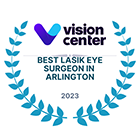
“We're so excited and so happy to be able to offer our patients the greatest technology in cataract surgery,” says Dr. Wesam Silk.
Dr. Silk, a LASIK surgeon serving patients in Washington D.C. and Northern Virginia, offers light adjustable lenses. Now, he makes these lenses available to cataract surgery patients who can, as he says, “try them out in the real world.”
What is a light adjustable lens?
According to the Silk Vision & Surgical Center, the Light Adjustable Lens™ by RxSightⓇ is “the first and only FDA-approved intraocular lens.” It improves vision after cataract surgery and doesn't cause glare like certain glasses might.
The light adjustable lens (LAL) material is implanted onto a patient during an eye correction operation. The LAL becomes altered when making contact with UV light.
An ophthalmologist who applies LALs during cataract treatments gives patients the chance to test their vision. Light adjustable lenses can be changed easily after a few weeks of surgery. This allows recipients to test the effectiveness of the lenses.
Example Light Adjustable Lens Testing Scenarios
Dr. Silk mentions light adjustable lens testing in a variety of everyday scenarios. For instance, he says that people should use them while reading or working.
It’s also important for patients to try them out while driving. In this case, wearers would probably want to make their behind-the-wheel assessment on a private driveway or road. Wearing while driving in a remote area instead of through a busy intersection just makes sense safety wise.
There’s no need for patients to worry, however. You can usually still see right after surgery, with some slight blurriness for a couple of weeks.
Another important area of testing for you is when working on hobby projects or crafts. Pay particular attention to times when your work, such as when painting or inserting tiny screws, requires precision.
Concerning precision, you will also want to test your LALs out when working on home improvement projects. Stay safe during the testing process after surgery. The tests done within three weeks will determine the best lens strength for you.
The Light Adjustable Lens Adjustment Process
Real-world testing will give you the best results come time to have your LALs adjusted. However, you can also gain assurance within a safe, controlled environment.
During the light adjustable lens adjustment process, Dr. Silk or another qualified ophthalmologist will set you in front of a Light Delivery Device (LDD). During this process, you will look into non-invasive UV light sources.
You can change your lenses for three weeks, but Silk Vision & Surgical Center can start adjusting them in a few days. Three days after your initial treatment, you will meet with your cataract specialist and communicate about your vision goals.
What you tell the Silk Center about your vision progress will determine how many adjustment sessions you need. The number of lens alterations may also be according to how severe your vision loss is before you receive your LASIK surgery or other procedure.
How to Experience The Best Results after Cataract Surgery
The Silk Vision Center will most likely recommend that you wear protective glasses after surgery. The times when you need them the most is when you expose yourself to any sources of UV light, including the sun and indoor grow lamps.
This will control the amount of UV that comes in contact with your eyes during recovery. As a result, you will experience progress during your adjustment sessions without interference.
Aside from wearing protective glasses, communication is key. You have to be honest with the surgeon who operates on your eyes. Do you experience some blurriness still, or are you getting headaches?
Your experience matters greatly during the light adjustable lens process, and it is crucial that you communicate with Dr. Silk and his staff about how you are feeling and any concerns you may have. By sharing your experiences, you provide valuable information that can help Dr. Silk tailor the treatment to your specific needs and ensure the best possible outcome.
Throughout your procedure, inform Dr. Silk about any discomfort or changes you experience during the consultation, surgery, and postoperative period. By doing so, you enable him to make necessary adjustments and provide you with the appropriate guidance and support.
The information you provide to Dr. Silk and his staff not only helps them understand your individual circumstances but also plays a significant role in determining the postoperative instructions you receive. These instructions are crucial for your recovery. They will assist you in caring for your eyes and managing any potential side effects or issues.
By openly communicating with Dr. Silk and his team, you can ensure that your recovery process is smooth and successful. They rely on your feedback to monitor your progress, address any concerns promptly, and make any necessary modifications to your treatment plan.
Remember, your experience and feedback are invaluable in shaping your eye surgery journey. By actively participating in the process and sharing your thoughts and experiences, you contribute to the overall success of your surgery and help Dr. Silk provide you with the best possible care.
Conclusion: Ideal Light Adjustable Lens Candidates
The most ideal light adjustable lens candidates are those who may have cataracts or vision problems. However, they will experience the best results if they don’t have any severe tissue damage resulting from irreversible injuries or eye diseases.
Also, keep in mind that some previous eye surgery may affect how well your surgery works. It depends on the type of treatments you have had in the past and what they were for, however.
LAL surgery is not recommended for anyone who has glaucoma or macular degeneration. It also may not work on people who have severely irregular cornea (irregular outer eye shapes).
For the people that LAL has worked for, however, it improved their chances of achieving 20/20 than when receiving traditional intraocular lenses. See Dr. Silk for a consultation before you proceed with light adjustable lens cataract surgery.











.png)

